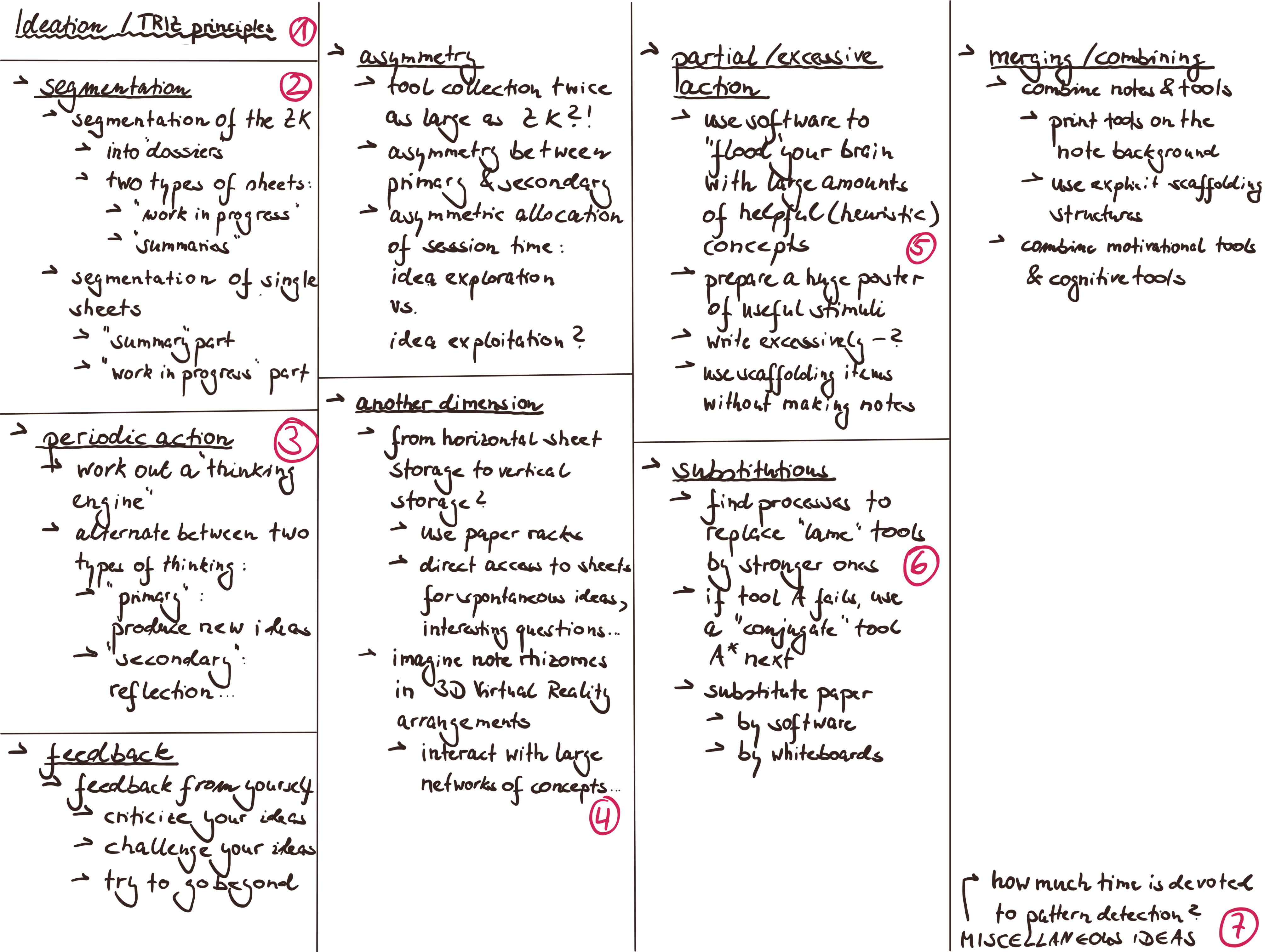Sharing a zettel: Ideas from TRIZ principles
I find @Will's idea of sharing zettels great - so here comes my latest example, with a number of remarks. 
Remarks:
- The 2013 Zettelkasten Exhibition in the Literaturmuseum der Moderne in Marbach/Germany was titled "Zettelkästen. Maschinen der Phantasie" (perhaps roughly "Zettelkästen. Machines of Imagination"). I'm fascinated by the question how a zettelkasten can support creative processes. My zettel shows one of the approaches I am experimenting with.
- The basic idea is the following: I collect ideas triggered by the question "How can inventive principles from the TRIZ method be used to make zettelkasten work more interesting, successful or effective?" Background: TRIZ is the "theory of inventive problem solving", and one of its key components is a list of 40 (or so) inventive principles that played a central role in a large number of inventions - indeed, the list was derived from the analysis of thousands of patents. These principles seem like good starting points to generate ideas. Using these principles merely as stimuli is arguably a bit unsophisticated in comparison with the full apparatus of TRIZ, but it works for me in this reduced version. As I've described elsewhere, I have a set of sticky notes at my work place, and the list of TRIZ principles is one of these notes.
- The main function of the zettel is to help with the creation of promising ideas. The ideas on virtual reality environments in (4), the idea of "concept flooding" in (5) and the ideas on "conjugate tools" in (6) are perhaps the most interesting ones. My focus with this zettel is the illustration of the process of idea generation, not how this zettel is embedded in the network of zettels in a zettelkasten. It seems natural to spend time with generating ideas in this or a similar fashion, then collect the most interesting ones and then spend time with a careful examination of these ideas.
I like the following "combinatorial" term for a class of "integrated thought development environments":
zettelkasten x layouts x tools
where we can combine different zettelkasten concepts with different sheet layouts and different tools. In this case, I found the "four column layout" or 4CL helpful - I have some note making flexibility in jumping between columns and using boxes of variable size. As an alternative, I could use a 3x3 array of small mind maps. Instead of the TRIZ principles, I could use different creativity tools or stimuli.Transferring key ideas from paper to digital canvases should be easy.
- Disclosure: For various reasons, tidy handwriting being one of them, I've compiled the zettel for this posting. I hope that some central features have become clear.
Howdy, Stranger!

Comments
@thomasteepe, thanks for sharing. The principles of invention can indeed be applied to the invention of ideas. You seem to be hinting at this. The eight principles you included in your note are the ones most easily applied to zettelkasting and ideation.
In another dimension, I love the reference to notes as rhizomal bodies arranged in a three-dimensional space. This brings to mind the great aspen colonies interconnected and comingling as single entities. I don't know much about Gilles Deleuze and Félix Guattar's philosophy, which uses the terms "rhizome" and "rhizomatic" to describe theory and research that allows for multiple, non-hierarchical entry and exit points in data representation and interpretation. Just what Wikipedia says. This might be interesting to follow.
In substitutions, you could apply this to refactoring ideas. Substituting a lamely framed idea with a stronger one. This might require writing excessively.
This note describes many things to be on the lookout for when in a creative mood. To expose hidden novel ideas, these might be atomized further and connected with the rest of your zettelkasten.
I'm stealing this "Zettelkästen. Machines of Imagination".
Will Simpson
My peak cognition is behind me. One day soon, I will read my last book, write my last note, eat my last meal, and kiss my sweetie for the last time.
My Internet Home — My Now Page
@thomasteepe, thanks for sharing.
A small nitpick. TRIZ is "теория решения изобретательских задач", "a theory of solving inventing problems". The meaning is slightly different.
It was created by a Soviet intellectual to analyze a process of producing technological inventions first and foremost (hence the name) and optimize that process. That's why several of principles of TRIZ directly mention a physical process or property. Up to 1990-s it had a small movement in USSR focused on technical problems first and foremost.
In the 1990-s it was expanded to solving "life problems in general". It's then the Soviets began to try to apply their fundamental and heavy industry knowledge to everyday life (and sell that knowledge on the market).
@emps - thanks for the information.
I had taken the phrasing "theory of inventive problem solving" from the wikipedia article on TRIZ, but was unaware of the difference in meaning.
I found the list of inventive principles interesting as stimuli for creativity - you can take a non-obvious general principle and try to apply it to your domain of interest. For domains linked to writing, ZKs etc. I found indeed the more "physical" of the TRIZ principles (like using thermal expansion or porous materials or strong oxidizers) not too helpful, and I've removed them from the "tool note" I use.
A somewhat more general method - "find a domain X that shares some structural elements with your domain A of interest, and try to transfer crucial ideas from X to A" is something I've experimented with a lot.